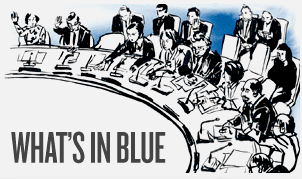Open Debate and Draft Resolution on Protection of Critical Infrastructure against Terrorist Attacks
On Monday (13 February), the Security Council will hold an open debate on the protection of critical infrastructure against terrorist attacks. The session will be chaired by Ukraine’s Foreign Minister Pavlo Klimkin and is a follow-up to the 21 November 2016 Arria-formula meeting that Ukraine organised on this issue. The Secretary-General’s Chef de Cabinet, Maria Luiza Ribeiro Viotti, is expected to brief. Other briefers will be Jürgen Stock, the Secretary-General of the International Criminal Police Organization (INTERPOL), via video-teleconference; Hamid Ali Rao, Deputy Director-General of the Organisation for the Prohibition of Chemical Weapons; Chris Trelawny, Special Adviser on Maritime Security and Facilitation to the Secretary-General of the International Maritime Organization; and Olli Heinonen, Senior Advisor on Science and Non-proliferation at the Foundation for Defense of Democracies and a former Deputy Director-General of the IAEA. The Council is expected to adopt a resolution drafted by Ukraine, which was put in blue on Thursday following at least five meetings to negotiate the text.
Protection of critical infrastructure has been a priority issue for Ukraine. During the General Assembly’s high-level week in September, President Petro Poroshenko called for the Council’s action in response to growing threats. Critical infrastructure systems include banking and finance; telecommunications; emergency services; air, maritime and rail transportation; and energy and water supplies; though what constitutes critical infrastructure is likely to vary among states.
The concept note prepared by Ukraine notes that attacks on these systems can cause chaos in societies, along with loss of civilian life, destruction of property and disruption of public services. There may also be environmental consequences that can extend beyond the targeted state, affecting neighbouring countries. States are made more vulnerable to this threat through developments in information and communication technology (ICT) that link many of these systems. Examples of such attacks include the Islamic State in Iraq and the Levant (ISIL) attacks on Brussels’ Zaventem airport and metro on 22 March 2016. The energy sector has been a target for terrorist groups, whose attacks can have cascading effects, in addition to the capture of numerous oil fields in recent years that provide groups like ISIL with significant revenue.
Member states may discuss issues, as suggested in the concept note, such as how to enhance the security of infrastructure and public areas; to improve responsiveness and resilience to terrorist attacks against critical infrastructure, in particular ICTs; and to strengthen public-private partnerships. They may consider mechanisms for the exchange of best practices, and how UN specialised agencies and other international and regional organisations can contribute to improving efforts to counter the terrorist threat to critical infrastructure.
International conventions on terrorism have addressed the protection of infrastructure in treaties specifically related to civil aviation, maritime security and nuclear weapons, while resolution 2309, adopted in September 2016, addressed the threat to civil aviation systems. The draft resolution is the first resolution to consider the threat of terrorism to critical infrastructure as a whole. Its elements include calling on states to consider developing or further improving their strategies for reducing risks to critical infrastructure from terrorism, by assessing and raising awareness of relevant risks and taking measures to mitigate these risks, including responses to possible attacks. It further encourages the cooperation of states in dealing with the threat, and acknowledges the significant impact from terrorist attacks on critical infrastructure..
The draft resolution includes several paragraphs directed to the Counter Terrorism Committee (CTC), the Counter Terrorism Executive Directorate (CTED) and other related UN bodies, some of which were the most difficult to negotiate. At least one member was concerned about expanding CTED’s mandate, which already faces capacity constraints, and could divert its attention from its other work. In a meeting with Council members during the negotiations, CTED said that consideration of critical infrastructure threats is already an aspect of its support to member states for implementing resolution 1373. Members subsequently agreed to language indicating that the CTC and CTED should continue as appropriate, within their respective mandates, to examine member states efforts to protect critical infrastructure from terrorist attacks.
There were also differences over the type of follow-up action needed on the implementation of the resolution. As a result, instead of requesting a Secretary-General’s report on the resolution in a year as initially proposed, the draft resolution requests the CTC to provide an update to the Council in twelve months.
How states manage their infrastructure systems was an issue during negotiations. Members such as China, Bolivia and Egypt mostly maintain public control of their infrastructure systems, whereas the private sector plays a more prominent role in states such as the US, Western European countries and Ukraine. While the initial draft noted that each state determines what constitutes its critical infrastructure, as a result of a proposal by China, language was added to emphasise the role of the state in determining how to effectively protect critical infrastructure. In addition, references to cooperation with the private sector and public-private partnerships have been conditioned “as appropriate”.

